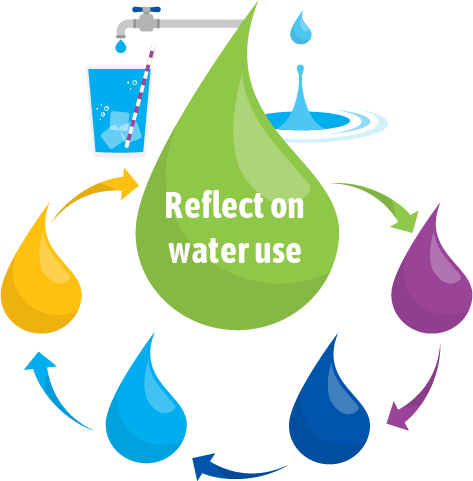ACTIVITY
Water use challenge

Curriculum links : Levels 3-4
Science:
Nature of Science: Investigating in science, Participating and contributing
Social science: Social studies
Mathematics: Numbers and algebra. Number strategies and knowledge
Activity Idea
In this activity, students take part in a water challenge to investigate how much water we need for our essential daily tasks. Students will experience how people make decisions about their water use according to how much is available.
By the end of this activity, students should be able to:
- investigate their daily water use at school and at home
- calculate water use using numeracy skills
- participate in a water challenge, making decisions about how to prioritise water use.
What you need
- Water Use Challenge - Activity 7 doc
- Student handout Water use for one day
- Student handout Water for one day challenge
- Student handout Water use priorities - older students
- Student handout Water use priorities - younger students
- Student handout Water use priorities answers
FOR TEACHERS
Introduction
Many people around the world live with huge water challenges and have to prioritise their water uses every day.
In Aotearoa New Zealand, we are lucky to not have to think about water priorities often, with reliable supplies of clean treated water provided to our taps. We currently have few water challenges, but what if it wasn’t this way? Carrying out a water challenge with limited water amounts is useful to help students appreciate that our priorities for water use may change according to how much water we have available.
During summer, we often face more restrictions on how water can be used – for example, sprinkler and hose bans. To find out about any current water restrictions in the Waikato area, see the Smart Water alert levels webpage.



Introducing a daily water use challenge
1. Discuss daily water use with students. Make predictions about how much water they use per day. Would this change according to the alert level? See Smart water alert levels webpage
How much water do we use?
2. This table shows how water use has changed in the Waikato over the last 10–15 years
|
District |
2010 water use Litres per person, per day (L/pp/d) |
2021 water use Litres per person, per day (L/pp/d) |
|---|---|---|
|
Hamilton |
250 |
214 |
|
Waipā |
250 |
180 |
3. Consider and discuss possible reasons for these changes. Questions to deepen student understanding:
How has the amount of water used in each district changed over time?
- Why do you think this is?
- Is the amount of water we use related to how much water is available?
- Calculating daily water use
Calculating daily water use
4. Use the student handout Water use for one day to help calculate all the water individuals use in one day. Individuals are encouraged to take the sheet with them to record their personal use over the day. This can include the water used both at school and at home. After recording the water use for 24 hours, add up each table to find the total water used. Ensure students are aware that the water use amounts are estimates – the volume of water will vary due to the water pressure within the building, whether the tap is opened fully etc.
Water use challenge
5. Use the student handout Water for a day challenge to raise awareness of what it is like to live with low water availability. Use the information and data on the student handout Water use for one day to plan how an individual could achieve a goal of either 50 litres, 80 litres or 100 litres of water use per day. Which water uses could they do without?
6. Use the student handout Water use priorities and possible answers to help to plan water use for the day or to reflect on the experience.
Thinking about water-saving actions
Discuss actions that everyone can take to save water.
Easy water saving actions:
- Turn the tap off when I brush my teeth.
- Use hand sanitiser.
- Take a shorter shower.
- Have a bath half full instead of full.
- Use a watering can instead of a hose or sprinkler.
More difficult/expensive actions:
- Have a low-flow shower head.
- Have a dual-flush toilet.
- Have a new dishwasher instead of an old one.
- Have a front loader washing machine instead of a top loader.
Reflection questions
- Calculate how much water you would use in a week, a month and a year – what are your totals?
- Did this amount surprise you? Give reasons for your answer.
- Which water uses could you live without in the short term and long term?
- How might your water use change as a result of doing this activity?
This activity is part of a suite of resources that support Smart Water – a context for learning, which provides students and teachers with opportunities to connect with water and learn more about drinking water in the Waikato region. The science and mātauranga concepts that underpin Smart Water are transferable to other locations in Aotearoa New Zealand. Smart Water is a partnership between Hamilton City Council, Waipā District Council and Waitomo District Council. It aims to foster a greater understanding and appreciation of water from source to tap and supports schools, organisations and communities to use water sustainably.
Water for a day challenge
Water use priorities
Possible answers: Water use priorities
